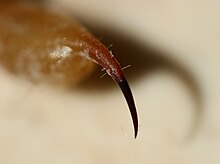Scorpion sting
Appearance
| Scorpion sting | |
|---|---|
 | |
| A scorpion's stinger. |
Scorpion stings are a cutaneous condition caused by the stinging of scorpions, usually resulting in pain, paresthesia, and variable swelling. The anatomical part of the scorpion that delivers the sting is called a "telson".[1][2]
Most scorpion stings vary from small swelling to medically significant lesions in severity, with only a few able to cause severe allergic, neurotic or necrotic reactions. However, scorpion stings account for approximately 3000 deaths a year worldwide[3].
Two species of scorpions can inflict stings which result in death of normal healthy humans: the Palestinian deathstalker (Leiurus quinquestriatus) and the Brazilian yellow scorpion (Tityus serrulatus). Antivenom exists for both species' stings.
References
- ^ James, William D.; Berger, Timothy G.; et al. (2006). Andrews' Diseases of the Skin: clinical Dermatology. Saunders Elsevier. p. 455. ISBN 0-7216-2921-0.
- ^ Rapini, Ronald P.; Bolognia, Jean L.; Jorizzo, Joseph L. (2007). Dermatology: 2-Volume Set. St. Louis: Mosby. pp. Chapter 83. ISBN 978-1-4160-2999-1.
- ^ Chippaux, Jean-Philippe (July 5, 2012). "Emerging options for the management of scorpion stings". Drug Design, Development and Therapy: 165. doi:10.2147/DDDT.S24754. ISSN 1177-8881. PMC 3401053. PMID 22826633.
{{cite journal}}: CS1 maint: unflagged free DOI (link)
External links
